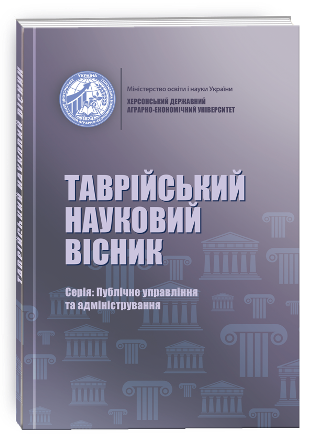CYBERSECURITY IN UKRAINIAN EDUCATIONAL INSTITUTIONS: MAIN PROBLEMS AND WAYS TO SOLUTIONS
DOI:
https://doi.org/10.32782/tnv-pub.2025.2.5Keywords:
information security, participants in the educational process, cybercrime, educational institutions, cyber hygiene, data leakage, phishing, ransomwareAbstract
The actualization of the issue of cybersecurity in Ukrainian educational institutions is due to the sharp increase in the digital dependence of the educational process and the simultaneous increase in the number of cyber incidents in this area. Educational institutions are increasingly becoming objects of cyberattacks due to weak mechanisms for protecting personal data and insufficient training of participants in the educational process. The purpose of the study is to highlight the main problems of cybersecurity in Ukrainian educational institutions and find effective ways to solve them. The work uses the system analysis method to identify relationships between technological, organizational and personnel vulnerability factors; the content analysis method – to assess the current state of cybersecurity based on modern publications and regulatory sources; the classification method – to organize the main types of cyber threats; the problem-target analysis method – to identify key barriers to the implementation of security measures; the inductive generalization method – to formulate practical directions for solving the identified problems. The research has classified the types of cybercrimes in the educational environment, focusing not only on technical but also on socio-technical threats. The second task involved identifying the main barriers to implementing cybersecurity: six areas of problems were identified, including institutional unpreparedness, staff shortage, lack of funding, low digital culture, technical vulnerability, and fragmentation of security policies. The third task was to formulate strategic solutions, including: implementing integrated incident response policies, modernizing technical infrastructure, developing digital competence of personnel, and institutionalizing a culture of cyber hygiene. The study confirmed that to truly improve cybersecurity, educational institutions need not only to modernize infrastructure, but also to change management approaches, improve the digital culture of all participants in the educational process, and form a sustainable practice of responding to cyber threats.
References
UK Government. Cyber security breaches survey 2023: education institutions annex. 2023. URL: https://www.gov.uk/government/statistics/cyber-security-breachessurvey-2023/cyber-security-breaches-survey-2023-education-institutions-annex (дата звернення: 11.04.2025).
Mascellino A. Exploitation accounts for 29% of education sector attacks. Infosecurity Magazine. 2023. URL: https://www.infosecurity-magazine.com/news/exploitation-29-education-sector/ (дата звернення: 11.04.2025).
Доценко С. О. Кібербезпека учасників освітнього процесу в умовах дистанційного навчання. Психолого-педагогічні проблеми вищої і середньої освіти в умовах сучасних викликів: теорія і практика : матеріали VIІ Міжнародної науково-практичної конференції, 16–18 березня 2023 р. Харків, 2023. С. 207–209. URL: https://dspace.hnpu.edu.ua/handle/123456789/11649 (дата звернення: 11.04.2025).
Карабін О.Й., Шуль М.В. Формування цифрових компетентностей здобувачів освіти в контексті нової української школи. Інноваційна педагогіка. 2020. №29(1). С. 140-144. DOI: https://doi.org/10.32843/2663-6085/2020/29-1.28.
Арсенович Л.А. Інструментарій підвищення рівня цифрової компетентності фахівців із кібербезпеки в освітньому процесі. Електронне фахове наукове видання «Кібербезпека: освіта, наука, техніка». 2022. № 3(15). С. 93–109. DOI: https://doi.org/10.28925/2663-4023.2022.15.93109
Бєляєва Н., Зацерковна О., Ребрина М. Проєктування безпечного освітнього середовища в умовах реформування нової української школи. Грааль науки. 2023. № 30. С. 288–292. DOI: http://dx.doi.org/10.36074/grail-of-science.04.08.2023.046
Wada І., Izibili G.О., Babayemi Т., Abdulkareem А. AI-driven cybersecurity in higher education: A systematic review and model evaluation for enhanced threat detection and incident response. World Journal of Advanced Research and Reviews. 2025. №25(3). Р. 2233-2245. DOI: http://dx.doi.org/10.30574/wjarr.2025.25.3.0989
Nkambule М., Vuurenj J. J., Leenen L. Creating a cybersecurity culture framework in higher education. Proceedings of the 20th International Conference on Cyber Warfare and Security. 2025. №20(1). P. 304–312. DOI: https://doi.org/10.34190/iccws.20.1.3268
Watini, S., Davies, G., Andersen, N. Cybersecurity in learning systems: Data protection and privacy in educational information systems and digital learning environments. International Transactions on Education Technology. 2024. № 3(1). Р. 26–35. DOI: http://dx.doi.org/10.33050/itee.v3i1.665
Kakembo А. Cybersecurity in Educational Institutions: Management Strategies. Еurasian Experiment Journal of Humanities and Social Sciences. 2025. № 6(2). Р. 51–56.
European Union Agency for Cybersecurity. ENISA Threat Landscape 2024: July 2023 to June 2024. 2024. URL: https://www.enisa.europa.eu/publications/enisathreat-landscape-2024 (дата звернення: 11.04.2025).
Рада національної безпеки і оборони України. Проєкт. Стратегії кібербезпеки України (2021–2025 роки). 2021. URL: https://www.rnbo.gov.ua/files/2021/STRATEGIYA%20KYBERBEZPEKI/proekt%20strategii_kyberbezpeki_Ukr.pdf (дата звернення: 11.04.2025).
Про основні засади забезпечення кібербезпеки України : Закон України від 05.10.2017 № 2163-VIII. Відомості Верховної Ради, 2017, № 45, C. 403.
Про внесення змін до деяких законів України щодо захисту інформації та кіберзахисту державних інформаційних ресурсів, об’єктів критичної інформаційної інфраструктури : Закон України від 27.03.2025 № 4336-IX. URL: https://zakon.rada.gov.ua/laws/show/4336-IX#Text (дата звернення: 11.04.2025).







